
The North American Numbering Plan (NANP) is a telephone numbering plan for twenty-five regions in twenty countries, primarily in North America and the Caribbean. This group is historically known as World Zone 1 and has the telephone country code 1. Some North American countries, most notably Mexico, do not participate with the NANP.

Area codes 920 and 274 are telephone area codes in the North American Numbering Plan (NANP) for a large area of eastern Wisconsin. Area code 920 was created on July 26, 1997, in a split of area code 414, one of the original North American area codes of 1947. 274 was added to the same numbering plan area (NPA) on May 5, 2023 to create an area code overlay.

Area codes 702 and 725 are telephone area codes in the North American Numbering Plan (NANP) for Clark County, including Las Vegas, in the U.S. state of Nevada. Area code 702 was one of the original North American area codes established in October 1947, and serviced the entire state of Nevada until 1998, when it was reduced to Las Vegas and the surrounding area. In 2014, area code 725 was added as an overlay plan covering the same area.

Area code 952 is the telephone area code in the North American Numbering Plan (NANP) for the southwestern suburbs of Minneapolis-St. Paul in the U.S. state of Minnesota. The numbering plan area (NPA) includes cities such as Bloomington, Eden Prairie, Edina and Minnetonka. It was created in 2000 along with area code 763 when they were carved out of area code 612, which now only contains Minneapolis and a few inner-ring locales.

Area code 564 is a telephone overlay area code in the North American Numbering Plan (NANP) for Western Washington state, including metropolitan Seattle. The area code was first proposed in 1999 to relieve telephone number shortages in area code 360, but implementation was delayed until 2017, when it was installed for an overlay complex that comprises only the numbering plan area 360. Neighboring area codes 206, 253, and 425 were slated for expansion of the overlay upon exhaustion of central office codes in each NPA. In 2023, area code 206 was approved for expansion with a guide line for preparation of inclusion of at least nine months. Ten-digit dialing has been mandatory in all of western Washington since July 29, 2017.
Telephone number pooling, thousands-block number pooling, or just number pooling, is a method of allocating telephony numbering space of the North American Numbering Plan in the United States. The method allocates telephone numbers in blocks of 1,000 consecutive numbers of a given central office code to telephony service providers. In the United States it replaced the practice of allocating all 10,000 numbers of a central office prefix at a time. Under number pooling, the entire prefix is assigned to a rate center, to be shared among all providers delivering services in that rate center. Number pooling reduced the quantity of unused telephone numbers in markets which have been fragmented between multiple service providers, avoided central office prefix exhaustion in high growth areas, and extended the lifetime of the North American telephone numbering plan without structure changes of telephone numbers. Telephone number pooling was first tested for area code 847 in Illinois in June 1998, and became national policy in a series of Federal Communications Commission (FCC) orders from 2000 to 2003.
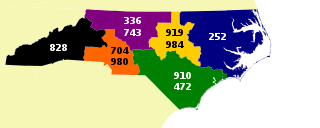
Area codes 704 and 980 are telephone area codes in the North American Numbering Plan (NANP) for Charlotte and all or part of 12 surrounding counties in south-central North Carolina. Other major cities in the service area are Gastonia, Kannapolis, Concord, Mooresville, Salisbury, Statesville, and Shelby. The South Carolina side of the Charlotte metropolitan area is part of area codes 803 and 839. Area code 704 is one of the original area codes assigned to numbering plan areas (NPAs) by AT&T in October 1947. Area code 980 was added in an overlay numbering plan in 2000.

Area code 334 is a telephone area code in the North American Numbering Plan (NANP) for southeastern Alabama. It was created on January 15, 1995, in an area code split from area code 205. It was the first new area code in Alabama since the announcement of the area code system in 1947. To permit a transition period for the reconfiguration of equipment, such as computers and fax machines, use of area code 205 continued in the 334 region through May 13, 1995.

Area codes 214, 469, 972, and 945 are telephone area codes in the North American Numbering Plan (NANP) for Dallas, Texas and most of the eastern portion of the Dallas–Fort Worth metroplex. The area codes are assigned in an overlay complex to a single numbering plan area that was the core of one of the original area codes of 1947, area code 214.

Area code 509 is the telephone area code in the North American Numbering Plan (NANP) for the eastern part of the U.S. state of Washington. The numbering plan area (NPA) roughly comprises the state east of the Cascade Mountains, and includes Spokane, the Tri-Cities, Ellensburg, Yakima, Walla Walla, and Wenatchee. The area code was assigned in a split of area code 206 in 1956.
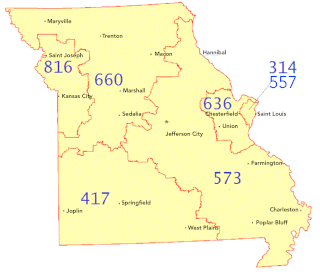
Area code 660 is the telephone area code in the North American Numbering Plan (NANP) for the northern and western part of the U.S. state of Missouri. It was created on October 12, 1997, in a split of the 816 numbering plan area (NPA)
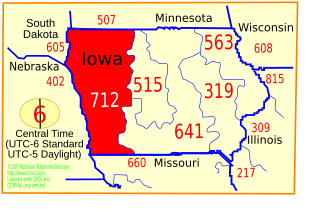
Area code 712 is the telephone area code in the North American Numbering Plan (NANP) for the most western part of Iowa, including the cities of Spencer, Le Mars, Sioux City, Council Bluffs, Red Oak, Sheldon, Storm Lake, Carroll, Sac City, and Shenandoah.
Area code 401 is the sole telephone area code in the North American Numbering Plan (NANP) for the U.S. state of Rhode Island. 401 is one of the original North American area codes, which were established in 1947.
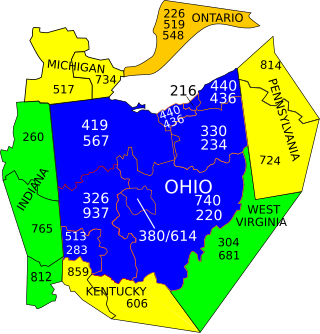
Area codes 513 and 283 are telephone area codes in the North American Numbering Plan (NANP) for the southwest of the U.S. state of Ohio, including Cincinnati and surrounding cities, such as Forest Park, Hamilton, Lebanon, West Chester, Mason, Maineville, Middletown, Milford, Norwood, Oxford, Harrison, Cleves, Miamitown and Trenton.

Area codes 303, 720 and 983 are telephone area codes in the North American Numbering Plan for the north-central portion of the U.S. state of Colorado. The numbering plan area comprises Denver and Boulder, as well as their surrounding suburbs, including Lakewood, Littleton, Longmont, Broomfield, Aurora, and Castle Rock. Area code 303 is the original area code, while area codes 720 and 983 were added to form an overlay complex for the area, meaning that the same geographic service area is served by all area codes and that ten-digit dialing is required for all calls made within the service area.

Area codes 816 and 975 are telephone area codes in the North American Numbering Plan (NANP) for most of the Missouri side of the Kansas City metropolitan area, the St. Joseph area, and all or part of 15 surrounding counties in northwestern Missouri. The numbering plan area originally comprised most of the northern and western two-thirds of the state, bordering with Arkansas, Illinois, Iowa, Kansas, Nebraska, and Oklahoma, but has been reduced to a ribbon bordering Kansas. 816 is one of the original 86 area codes created in 1947. The numbering plan area was converted to an overlay complex with area code 975 in 2023.
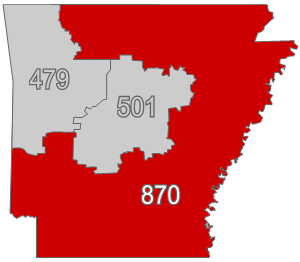
Area codes 870 and 327 are telephone area codes in the North American Numbering Plan (NANP) for southern, eastern, and most of northern Arkansas. It was created on April 14, 1997 in a split from area code 501, Arkansas's original area code of 1947.

Area codes 618 and 730 are telephone area codes in the North American Numbering Plan (NANP) for southern Illinois. The numbering plan area (NPA) comprises one hundred and twenty-six municipalities, such as Carbondale, Cairo, Belleville, East St. Louis, Edwardsville, Marion, O'Fallon, Alton, Mt. Vernon, Centralia, Herrin, Salem, Metropolis, Fairview Heights, Collinsville, and Granite City. Area code 618 was one of the original North American area codes created in 1947, and 730 was added to the plan area to form an overlay complex to satisfy the need for more telephone numbers in the region. The current population of the 618/730 area code is 1,288,816 people. It encompasses approximately 15,458 square mile ; and has a population density of 83.38 people per square mile.

Area code 864 is a telephone area code in the North American Numbering Plan (NANP) for the U.S. state of South Carolina. The numbering plan area (NPA) comprises the areas of Greenville, Spartanburg, Anderson, and twelve surrounding counties in upstate South Carolina. Other cities in the 864 territory include Clemson, Gaffney, Greer, and Mauldin.















